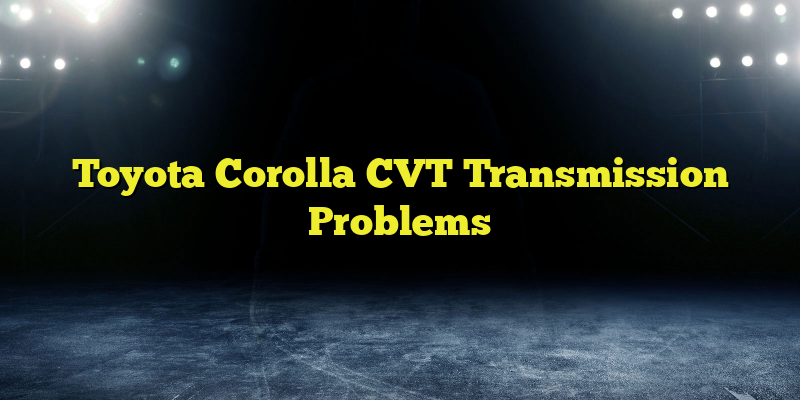Introduction
The Toyota Corolla is a popular compact car known for its reliability and fuel efficiency. However, some models equipped with a Continuously Variable Transmission (CVT) have experienced issues over the years. In this article, we will discuss some of the common CVT transmission problems in Toyota Corolla and possible solutions.
1. **What is a CVT Transmission?**
A CVT transmission, or Continuously Variable Transmission, is an automatic transmission system that can seamlessly change through an infinite number of gear ratios. Unlike traditional automatic transmissions with fixed gear ratios, CVT continuously adjusts the gear ratio to provide optimal performance and fuel efficiency.
2. **CVT Transmission Problems in Toyota Corolla**
While CVT transmissions offer benefits such as smooth acceleration and improved fuel economy, they can also be prone to certain problems. Some of the common CVT transmission problems in Toyota Corolla include:
2.1. **Whining Noise**
One of the most reported issues with Toyota Corolla CVT transmissions is a whining noise during acceleration. This noise can be caused by various factors, such as a faulty bearing or a worn-out belt. It is important to have the transmission inspected and repaired by a qualified technician to prevent further damage.
2.2. **Slipping Gears**
In some cases, the CVT transmission in Toyota Corolla may experience slipping gears. This can happen when the transmission fails to maintain a constant gear ratio, resulting in a loss of power and acceleration. Slipping gears can be caused by a faulty solenoid or a worn-out belt, and should be addressed promptly to avoid further damage to the transmission.
2.3. **Overheating**
CVT transmissions are sensitive to heat, and overheating can lead to significant damage. In Toyota Corolla, overheating can be caused by a lack of proper maintenance, such as failure to change the transmission fluid at recommended intervals. Overheating can cause the transmission to shift improperly, resulting in jerky movements and reduced performance.
3. **Preventive Maintenance and Solutions**
While CVT transmission problems can be frustrating, proper maintenance and timely repairs can help prevent major issues. Here are some preventive measures and solutions:
3.1. **Regular Fluid Checks and Changes**
Regularly checking and changing the transmission fluid is crucial for maintaining the health of the CVT transmission. Toyota recommends changing the CVT fluid every 60,000 miles or as specified in the owner’s manual. This helps to prevent overheating and ensures smooth operation of the transmission.
3.2. **Avoiding Overloading and Harsh Driving**
Avoid overloading your Toyota Corolla and driving aggressively, as it can put extra strain on the CVT transmission. Excessive weight and harsh driving habits can accelerate wear and tear on the transmission components, leading to premature failure.
3.3. **Regular Inspections and Maintenance**
Regularly inspecting the CVT transmission for any signs of leaks, unusual noises, or slipping gears is essential. If you notice any issues, it is recommended to take your vehicle to a qualified technician for a thorough inspection and necessary repairs.
4. **Frequently Asked Questions (FAQs)**
Q: How can I identify if my Toyota Corolla has a CVT transmission?
A: You can identify if your Toyota Corolla has a CVT transmission by checking the vehicle’s specifications in the owner’s manual or contacting a Toyota dealership with your VIN (Vehicle Identification Number).
Q: How much does it cost to repair a CVT transmission in a Toyota Corolla?
A: The cost of repairing a CVT transmission in a Toyota Corolla can vary depending on the extent of the damage and the labor rates in your area. It is recommended to get a detailed estimate from a reputable repair shop or Toyota dealership.
Q: Can I replace a CVT transmission with a conventional automatic transmission?
A: While it is technically possible to replace a CVT transmission with a conventional automatic transmission, it is not recommended. The vehicle’s computer systems and drivetrain components are designed to work with a specific type of transmission, and swapping it may require extensive modifications and programming.










